The 20 Best Gangster Movies of All Time
Gangster cinema has many outstanding positions, which are characterized by artistic qualities. Films of this genre usually construct a certain code of values, which is a representation of the hard rules of the mafia world.
The origins of gangster movies date back to the late 1920s, as the first work of the genre is considered to be Josef von Sternberg’s “The Underworld” from 1927. In turn, in the next decade, whole series of very popular films about famous gangsters, such as Al Capone, were shot in the US. After that, the gangster film was dominated by the convention of black cinema with a slightly different type of protagonist: an often corrupt law enforcer who, while operating on the edge of the criminal world, tries to maintain his own code of rules. The icon of this period became Humphrey Bogart.
On the other hand, a kind of renaissance of the gangster film occurred in the 1970s, when Francis Ford Coppola’s great masterpiece “The Godfather” hit the screens. This started a trend of outstanding films about the Mafia by Martin Scorsese, Brian DePalma or John Huston. The 1980s, in turn, brought a reading of the genre through the prism of cinematic postmodernism. Thus, pastiche became the dominant style, referring to the classics of gangster cinema and its cult iconography. It consists of a portrait of the city at night, the light of street lamps, guns and fast cars. To this day it is a genre that has a huge number of loyal fans.
The best gangster movies
1. “The Godfather”
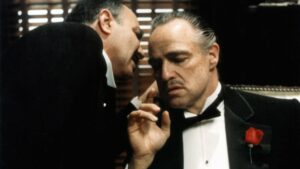
“The Godfather” and the next two parts of the trilogy are classics of the genre and also symbols of it. Francis Ford Coppola, based on the famous novel by Mario Puzo, created a penetrating picture of the Sicilian mafia operating in the United States. The role of Vito don Corleone was played by Marlon Brando (his younger incarnation was played by Robert De Niro), while the role of his son, Michael, taking over the Mafia legacy was played by Al Pacino. The suggestive female character, meanwhile, was created by Diane Keaton.
“The Godfather” is an undisputed masterpiece of the genre. To this day, it is still watched brilliantly, thanks not only to the superb direction and acting, but also to Gordon Willis’ cinematography imbued with an amber hue. The overall impression is complemented by the extremely atmospheric, brilliant music by Nino Rota. The film is not only a story about the changes in the gangster world, but also about the change in the model of American society. It can also be read as a metaphor for the end of the old Hollywood era, as well as a coded message about patriarchal culture.
2. “Once Upon a Time in America” (1984)
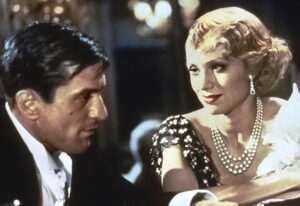
“Once Upon a Time in America” is a great mafia film directed by Sergio Leone, reminiscent of the style of 1940s cinema, with leading roles played by Robert De Niro (Noodles) and James Woods (Max). Female performances, meanwhile, were created by Tuesday Wels (Carol) and Elizabeth McGovern (Deborah). The movie tells the story of several gangsters hailing from a tough Jewish neighborhood in New York City. The story takes place over the course of several decades. Since 2014, you can also watch the director’s version of the film, the one that won critical acclaim at Cannes. This is because later Leone’s work was heavily truncated by the censors.
“Once Upon a Time in America” is memorable for its unusual combination of gangster plot and nostalgic poetics. Almost iconic shots of New York City, Ennio Morricone’s music and scenes shot in slow motion give the title a deeper, moving dimension.
3. “Goodfellas” (1990)
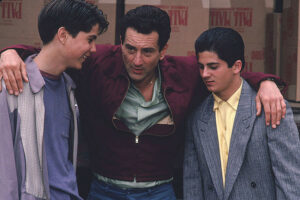
“Goodfellas”, on the other hand, is a great film by Martin Scorsese completely different in poetics from “The Godfather”. Scorsese’s work is characterized by the brutality of its depiction of a gangster environment governed by cruel laws. The film tells the story of the fate of mafioso Henry Hill (Ray Liotta), who eventually becomes a crown witness in the trial against the Mafia. Excellent performances were also given by Robert De Niro (as James Conway) and Joe Pesci.
“Goodfellas” is gangster cinema in its purest style, boldly, naturalistically exposing the brutality of the criminal world. The viewer can almost feel first-hand the emotions gripping the members of the mafia, who can never and nowhere be sure of their fate or trust anyone. Friendship, love or normal human ties in a world based on violence and ruthless rules have no place here.
4. “Carlito’s Way” (1993)
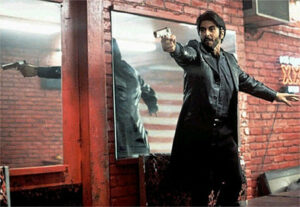
“Carlito’s Way” by Brian De Palma is an example of a successful combination of gangster cinema formula and melodrama. The main character (played by Al Pacino) after serving time in prison wants to return to a normal existence, but the mafia does not let him forget about himself. Carlito will have to pay the highest price for the mistakes of the past. The film also features outstanding performances by Sean Penn and Penelope Ann Miller.
“Carlito’s Way”, despite the gangster convention, is an overly universal cinema, presenting a special type of hero: an out-sider who believes in the possibility of redemption and closure of the past. The fatalism inherent in De Palma’s picture, however, grinds the necks of human intentions, not allowing the characters to forget what was.
5. “A Bronx Tale” (1993)
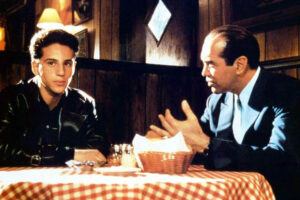
“A Bronx Tale” is a movie directed by Robert De Niro. It tells the story of a young man’s initiation into adulthood and the structures of the criminal world. The director also played one of the leading roles, with other characters played by Chazz Palminteri, Lillo Brancato, Francis Capra and Taral Hicks, among others.
“A Bronx Tale” is gangster cinema, but also an initiation. It is a story about coming of age, making moral choices, peeling and overthrowing authority figures. The film shows how important a role in the life of each individual plays an individual moral code, which, as it turns out, is not easy to follow not only in the mafia world.
6. “The Public Enemy” (1931)
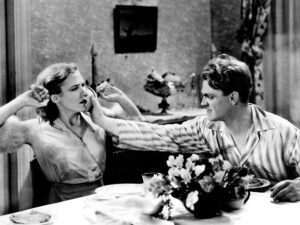
“The Public Enemy”, directed by William A. Wellman, is a classic of the gangster genre from 1931. The plot, set in the Prohibition era, refers to the biographies of the biggest mafiosi of the time. The role of the main character, Tom Powers, was played by James Cagney, while at his side as Gwen was played by the phenomenal Jean Harlow.
“The Public Enemy” went down in cinema history for many reasons. In addition to the brilliant performance of the main character, which opened the door to Cagney’s career, there are iconic scenes in this gangster story, ambivalent in meaning, based on actual observations of a dark environment. The most famous is the one when Cagney squeezes half a grapefruit on Mae Clarke’s face. Similar behavior was exhibited by gangster Hymi Weiss, who smeared an omelet on his partner’s face… Cagney, after the making of the film, when dining in restaurants, often encountered a situation where other guests sent a grapefruit to his table.
7. “Casino” (1995)
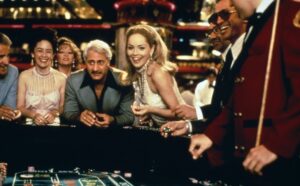
“Casino” is one of Martin Scorsese’s best works from 1995. The film is set in the dark world of gambling. Sam “Ace” Rothstein (Robert De Niro) is a mob man who is in charge of running the titular casino in Las Vegas. Soon the beautiful Ginger (Sharon Stone) falls in love with the wealthy owner of the gambling temple.
“Casino” is a real feast for lovers of gangster movies. There are shady deals, money, mafia snatches, friendship put to the test and, of course, a beautiful woman who means serious problems. The phenomenal Sharon Stone was awarded a Golden Globe and an Oscar nomination for her role.
8. “Bonnie and Clyde” (1967)
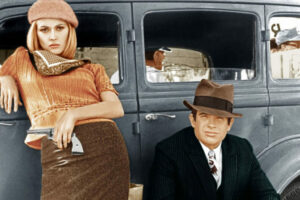
“Bonnie and Clyde” (1967), directed by Arhur Penn, set one of the new trends in the history of gangster cinema. For it is not so much a classic thriller story as a presentation of a pair of lover-murderers who wreak havoc across America. However, a life of perpetual travel with robbing banks and stores becomes a quest for self-destruction. Clyde is played by Warren Beatty, while Bonnie is played by Faye Dunaway.
“Bonnie and Clyde” is a peculiar combination of the 1930s gangster cinema formula with the counterculture era. The film was part of the American New Wave, and the main characters gained the status of modern rebels. The beautiful on-screen couple contrasts with the eruption of violence, and the final, highly aestheticized scene of the lovers’ deaths adds an extra dimension to the whole. The advertising slogan promoting the film was not coincidentally shockingly provocative: “They’re young, they’re in love and they kill people.”
9. “The Roaring Twenties” (1939)
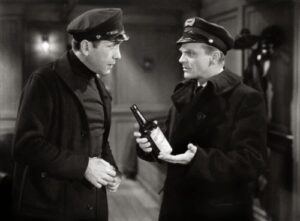
Raoul Walsh’s “The Roaring Twenties” is another classic of gangster cinema. The movie was made in 1939, and its hallmark became a certain profile of the main character – a tough mafioso, who nevertheless has his own value system. His embodiment was James Cagney, here as Eddie Bartlett, one of three friends operating in the dark underworld.
Martin Scorsese called “The Roaring Twenties” “the last great gangster film before the advent of film noir.” This is because, in his view, classic gangster cinema ended when gangsters turned into businessmen.
10. “Chinatown” (1974)
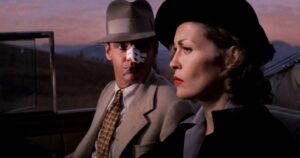
Roman Polanski’s “Chinatown” (1974) is a dark film using the poetics of cinema noir. The story is set in 1930s Los Angeles. The title is the name of that city’s Chinese neighborhood. Private detective Jake Gittes (played by Jack Nicholson) becomes involved in the dark affairs of a certain influential family. Evelyn Cross Mulwray was played by Faye Dunaway, while the other characters were played by John Huston, Perry Lopez and John Hillerman.
“Chinatown” impresses with a set design that sentimentally recreates the atmosphere of the 1930s – the fashion of the time, interior design, elegant cars and impeccable manners. The filmmakers consciously in opposition to the dynamic convention of 1930s gangster cinema build a slowed-down narrative pace, emphasized by Jerry Goldsmisth’s atmospheric music. Jazz-tinged compositions, with a solo trumpet part, capture the mood of romantic love and sad nostalgia for the past.
The best gangster films
11. “Scarface” (1983)
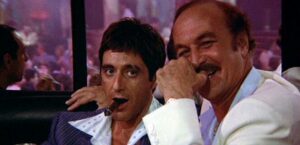
Brian De Palma’s “Scarface” is a well-known film of the 1970s, an exemplary realization of the rules of mafia cinema. In it, the director clearly referred to Howard Hawks’ 1932 work of the same name. Tony Montana (Al Pacino) abandons his native Cuba to deal drugs in the United States. The film also starred Steven Bauer and Michelle Pfeiffer.
The original “Scarface” alongside ” The Public Enemy” (1931) and “Little Caesar” set the canon of the classic gangster film. It was also one of the first films to feature a Thompson submachine gun (the so-called “Tommy gun”) as a prop.
12. “Heat” (1995)
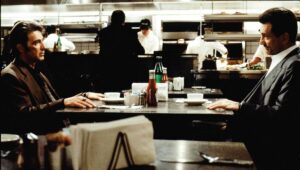
The list of gangster movies certainly can’t miss the famous “Heat”, directed by Michael Mann. Neil McCauley (Robert De Niro) along with his colleagues: Chris (Val Kilmer) and Michael (Tom Sizemore) rob a van carrying bonds. During the theft, an unplanned shootout occurs, resulting in the deaths of three guards. The investigation of the case is entrusted to Detective Vincent Hanna (Al Pacino), who will not rest until he solves the mystery of the gangster heist.
“Heat” is the film in which Robert De Niro and Al Pacino first met on the set. True, the actors had previously played with each other in “The Godfather”, but it was only in Mann’s film that they appeared together in a scene. Moreover, the picture interestingly and differently from the traditional pattern draws the relationship between the criminal and the law enforcement officer pursuing him.
13. “Mean Streets” (1973)
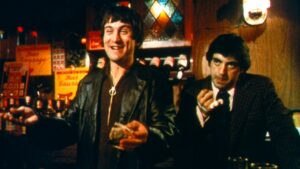
“Mean Streets” is another entry in Martin Scorsese’s oeuvre. The film dates back to 1973. It tells the story of an Italian mafia operating in New York City. The plot centers around the character Charlie (Harvey Keitel), who tries to control one of the local mafia.
“Mean Streets” is the first Martin Scorsese movie in which the director presented a full set of characteristic elements of his later cinema. Indeed, genre conventions are combined here with the filmmaker’s personal experiences and European inspirations. The great theme of Scorsese’s work also appears here: the attempt to preserve dignity and ethics in a thoroughly demoralized world.
14. “The Getaway” (1972)
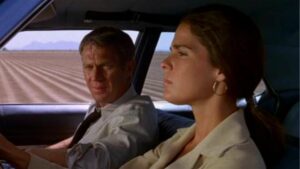
Sam Peckinpah’s “The Getaway” is a 1972 movie. The leading role was played by Steve McQueen. He played the role of a gangster who, together with his wife (Ali MacGraw), is forced to hide from the police and mafia revenge. After all, a failed bank heist draws the wrath of both the law and the criminal world on him.
“The Getaway” is both a gangster film, a road movie and a love story in one. And the latter genre is evoked, for example, by the star of the famous melodrama with such a title – Ali MacGraw. The actress, together with Steve McQueen, forms a stellar and phenomenal duo on the screen, which even after all these years is worth seeing again.
15. “Pulp Fiction” (1994)
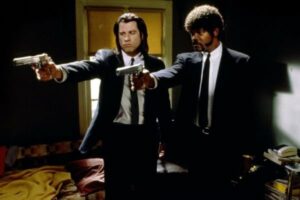
Quentin Tarantino’s cult film brought a new quality to gangster cinema. “Pulp Fiction” is an entertaining story of two paid assassins: Vincent Vega (John Travolta) and Jules Winnfield (Samuel L. Jackson), who miraculously escape with their lives during a “routine” operation. Is this a sign that they should retire from the industry? In addition to the aforementioned actors, bravura performances in Tarantino’s film were created by Uma Thurman, Bruce Willis and Ving Rhames.
Postmodern “Pulp Fiction” is a unique blend of quotes from pop culture and cinema. Dialogue rich in references, motifs from cinema noir, threads of screwball comedy and black comedy are tied together by ubiquitous and, above all, senseless violence lifted from the gangster world – as much portrayed as parodied.
16. “The Untouchables” (1987)
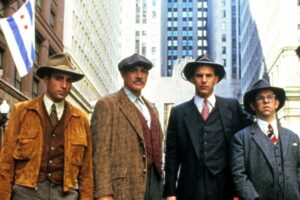
“The Untouchables” by Brian De Palma is a film set in the poetics of nostalgia for the old days. The work is set in the 1930s in Chicago, and the main character is agent Eliot Ness (Kevin Costner) fighting against the illegal sale of alcohol. The character of the legendary Al Capone is played by Robert De Niro.
“The Untouchables” is one of De Palma’s best movies, in which the director constructs a truly gangster spectacle. It is impossible not to mention here the Oscar-winning role of Sean Connery, playing the steadfast and principled policeman.
17. “Miller’s Crossing” (1990)
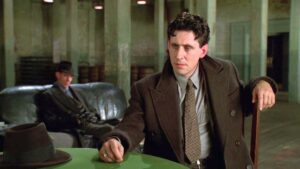
The Coen brothers’ “Miller’s Crossing” is another entry in the genre of pastiche of traditional gangster cinema. A mafia war between gangs is complicated by Tom’s (Gabriel Byrne) love for the beautiful Verna (Marcia Gay Harden), whose brother has been given a death sentence.
The film is a clear stylization of 1940s and 1950s cinema noir, with distinctive iconography and classic black film motifs. However, homoerotic elements that break the traditional pattern appear here.
18. “The Maltese Falcon” (1941)

“The Maltese Falcon” is an outstanding film by John Huston in the style of cinema noir. The leading role of private detective Sam was played by the irreplaceable Humphrey Bogart, trying to solve the mystery of the mysterious disappearance of the falcon statuette. Meaningful creations were also created by Mary Astor, Gladys George and Peter Lorre.
The picture, based on the novel by Dashiell Hammet, is an exemplary realization of film noir and at the same time a turning point in the careers of both John Huston and Humphrey Bogart. It was this work that shaped Bogart’s image as an interesting, yet cynical and life-experienced man. In turn, Arthur Edeson’s cinematography, full of luminous contrasts, builds up the typical dark atmosphere of a black crime film.
19. “Prizzi’s Honor” (1985)
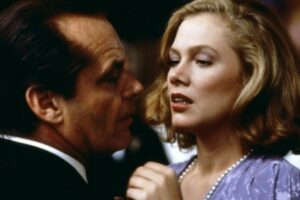
“Prizzi’s Honor” is another John Huston film from 1985. The center of the plot here is the conflict between fiery affection and mafia business. Charley Partanna (Jack Nicholson), an associate of the gangster Prizzich clan, is commissioned to assassinate his wife Irene (Kathleen Turner), who is a threat to the “family.”
On the occasion of this film it is worth mentioning the excellent cinematography of Andrzej Bartkowiak. In turn, a special asset of the production is the phenomenal Kathleen Turner, who in the 1980s experienced a real boom of her career. Thanks to her roles from this period, she became an iconic figure of a woman who decides to abandon her current lifestyle and reach for what she really wants. Turner created a model of a heroine maturing into independence and awareness of the power of her erotic charm, ready to sacrifice much to achieve her goals.
20. “The Asphalt Jungle” (1950)
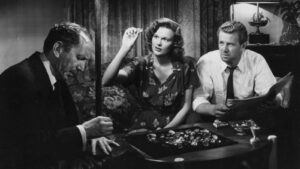
“The Asphalt Jungle”, directed by John Huston, is a film with a somewhat blurred genre affiliation, but it certainly shows elements of noir aesthetics and gangster cinema. The main character of the work is a thief who plans to commit jewel theft. The leading roles were played by Sterling Hayden, Louis Calhern, James Whitmore and Jean Hagen. Interestingly, Asphalt Jungle, is also one of the first films with Marilyn Monroe.
The asphalt jungle of the title, or the night face of the city, where the rules of the animal world rule, has become emblematic of the genre. What we have here is a blurring of the boundaries between good and evil, villains and lawmen, and dark and noble motives for action. And the whole is shrouded in an aura of unexpected romanticism, making itself known especially in the famous final scene.
Literature:
P. Kemp, “Cinema: The Whole Story”.
